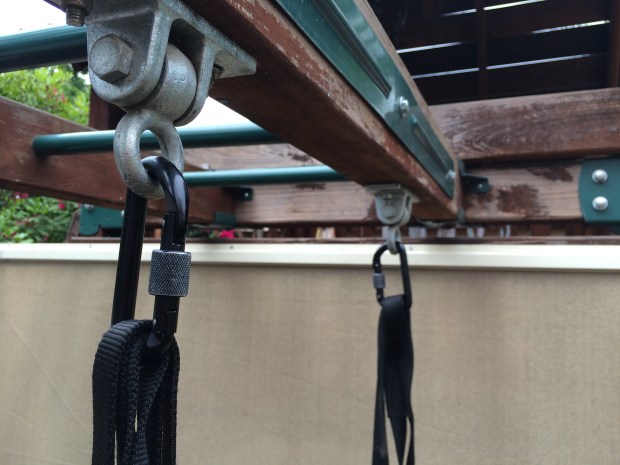
Gymnastic rings are excellent equipment for bodyweight fitness training. Anything from push-ups, dips, and pull-ups to advanced moves such as muscle-ups and the fabled Iron Cross can be done on a pair of gymnastic rings to improve core and upper-body strength and stability. Plus, as my kids can attest, it’s really fun to swing from them. Here is a great guide to getting started with the rings, and a fundamental rings workout routine.
You can purchase good, commercially made rings, but how about making your own instead? There are several examples online of DIY rings made from either plywood or PVC pipe.
You can create these wooden rings by laminating two pieces of 3/4″ plywood, cutting with a jigsaw, and then sanding.
These rings are made by filling PVC pipe with a length of rope and sand and then heating them in the oven to soften the plastic, and then form.
I have a set of commercial wooden rings (wood is the preferred material as it absorbs sweat, helping with your grip), but I’ve decided I’d like to make a second set with a slightly larger grip diameter (my current set is the 1.1” international size). I’d rather not use the jigsaw-cut cylinder method and the ensuing difficulty of sanding down straight walls to a perfect circle. My plan is to begin by laser cutting ten thin, stepped layers out of baltic birch, so that when stacked they are closer to the final profile. This approach should make it easier to sand them down to the proper circular profile after gluing.
Starting from from standard dimensions (1-1/4” diameter profile, 7” inside diameter) I drafted the design in Rhinocerous, a NURBS modeling tool I use for precise 3D modeling and laser cutter CAD drafting. (You could do the same in most any CAD or 3D modeling package.)
I then sliced my final design model into 1/8” cuts with a stepped square profile to mimic the laser cut materials I’d be assembling. This gave me ten circular slices to laser cut and assemble.
Since I’ll be stacking and gluing ten rings of varying size together, I replicated the profile curve of my stacked pieces and used this as a guide to create a laser-cut stacking/gluing jig. I’ll cut four of these into which to lay my ring slices for gluing and clamping.
I’ve ordered the baltic birch plywood, and am gearing up for laser cutting — and lots of sanding. If all goes well, I’ll get them super smooth, like my current set. (Because, otherwise, splinters. Which is bad.)
Also, a note on safety: make sure you rig your rings carefully from something that can support the load. You may buy buckled straps online made for rings, or, do as I have and use rock climbing web straps and carabiners to attach them to the backyard swing set.
If you’d like to get going and build your own gymnastics rings, you can download my design files here, on Thingiverse. Have fun, and please share your results.
ADVERTISEMENT












